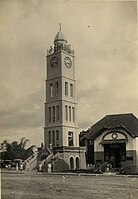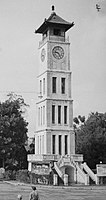
Minangkabau people, also known as Minang, are an Austronesian ethnic group native to the Minangkabau Highlands of West Sumatra, Indonesia. The Minangkabau's West Sumatran homelands was the seat of the Pagaruyung Kingdom, believed by early historians to have been the cradle of the Malay race, and the location of the Padri War.

West Sumatra is a province of Indonesia. It is located on the west coast of the island of Sumatra and includes the Mentawai Islands off that coast. The province has an area of 42,119.54 km2 (16,262.45 sq mi), with a population of 5,534,472 at the 2020 census. The official estimate at mid 2022 was 5,640,629. West Sumatra borders the Indian Ocean to the west, as well as the provinces of North Sumatra to the north, Riau to the northeast, Jambi to the southeast, and Bengkulu to the south. The province is subdivided into twelve regencies and seven cities. It has relatively more cities than other provinces outside of Java, although several of them are relatively low in population compared with cities elsewhere in Indonesia. Padang is the province's capital and largest city.

Rendang is a Minang dish originating from the Minangkabau region in West Sumatra, Indonesia. It has spread across Indonesian cuisine to the cuisines of neighbouring Southeast Asian countries such as Malaysia, Singapore, Brunei and the Philippines. Rendang is often described as a rich dish of meat — most commonly beef — that has been slow cooked and braised in a coconut milk seasoned with a herb and spice mixture, until the liquids evaporate and the meat turns dark brown and tender, becoming caramelized and infused with rich flavours.

Agam Regency is a regency of West Sumatra, Indonesia. It has an area of 2,264.89 km2 and had a population of 454,853 at the 2010 census and 529,138 at the 2020 census. The regency seat is the town of Lubuk Basung. Bukittinggi city is surrounded by this regency but is not administratively included in it.

Bukittinggi is the third largest city in West Sumatra, Indonesia, with a population of 111,312 in 2010 and 121,028 in 2020, and an area of 25.24 km2. It is in the Minangkabau Highlands, 90 km by road from the West Sumatran capital city of Padang. The whole area directly borders to the Agam Regency, making it an enclave, and is located at 0°18′20″S100°22′9″E, near the volcanoes Mount Singgalang (inactive) and Mount Marapi. At 930 m above sea level, the city has a cool climate with temperatures between 16.1° to 24.9 °C.

Rumah Gadang or Rumah Bagonjong "house for the Minangkabau people" are the traditional homes of the Minangkabau in West Sumatra, Indonesia. The architecture, construction, internal and external decoration, and the functions of the house reflect the culture and values of the Minangkabau. A Rumah Gadang serves as a residence, a hall for family meetings, and for ceremonial activities. In the matrilineal Minangkabau society, the Rumah Gadang is owned by the women of the family who live there; ownership is passed from mother to daughter.
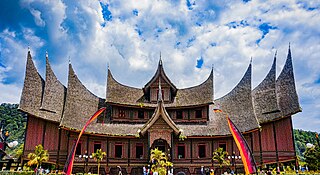
Pagaruyung Palace is the istana of the former Pagaruyung Kingdom, located in Tanjung Emas subdistrict near Batusangkar town, Tanah Datar Regency, West Sumatra, Indonesia. It was built in the traditional Minangkabau Rumah Gadang vernacular architectural style, but had a number of atypical elements including a three-story structure and a larger dimension in comparison to common rumah gadang.

Padang food or Minang food is the cuisine of the Minangkabau people of West Sumatra, Indonesia. It is among the most popular cuisines in Maritime Southeast Asia. It is known across Indonesia as Masakan Padang after Padang, the capital city of Western Sumatra province. It is served in restaurants mostly owned by perantauan (migrating) Minangkabau people in Indonesian cities. Padang food is ubiquitous in Indonesian cities and is popular in neighboring Malaysia and Singapore.
Minangkabau businesspeople refers to merchants from the Minangkabau Highlands in central Sumatra, Indonesia. Minangkabau are the ethnic majority in West Sumatra and Negeri Sembilan. Minangkabau are also a recognised minority in other parts of Indonesia as well as Malaysia, Singapore and the Netherlands.

Rumah adat are traditional houses built in any of the vernacular architecture styles of Indonesia, collectively belonging to the Austronesian architecture. The traditional houses and settlements of the several hundreds ethnic groups of Indonesia are extremely varied and all have their own specific history. It is the Indonesian variants of the whole Austronesian architecture found all over places where Austronesian people inhabited from the Pacific to Madagascar each having their own history, culture and style.
The Minangkabau legend told the story of the origin of the name "Minangkabau". It is thought to be a conjunction of two words, minang ("victorious") and kabau ("buffalo").

The Ganting Grand Mosque is a Sunni mosque located in Ganting, Padang, West Sumatra, Indonesia. Construction began in 1805, making it the oldest in Padang and one of the oldest in Indonesia. It is a Cultural Property of Indonesia.

Nasi padang, sometimes referred to as Padang rice, is a Minangkabau dish of steamed rice served with various choices of pre-cooked dishes originating from West Sumatra, Indonesia. It is named after the city of Padang, capital of the West Sumatra province. A miniature banquet of meats, fish, vegetables, and spicy sambals eaten with plain white rice, it is Sumatra's most famous export and the Minangkabau people's primary contribution to Indonesian cuisine.

Keripik sanjai or keripik sanjay is a Minangkabau cassava kripik or chips from Bukittinggi city in West Sumatra, Indonesia. It made from thinly sliced cassava deep fried in ample of coconut oil until crispy. It is commonly called keripik singkong in Indonesia, but this Minang version is probably the most popular of keripik singkong in Indonesia. And yet, the sweet, hot and spicy keripik sanjai balado is also the most famous variant of keripik sanjai.
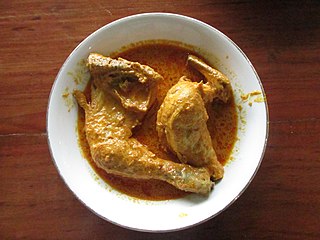
Gulai is a class of spicy and rich stew commonly found in Indonesia, Malaysia and Singapore. The main ingredients of this dish are usually poultry, goat meat, beef, mutton, various kinds of offal, fish and seafood, as well as vegetables such as cassava leaves, unripe jackfruit and banana stem.

Jami Mosque of Taluak is one of the oldest mosques in Indonesia, located in Taluak IV Suku Nagari, Banuhampu District, Agam Regency, West Sumatra. The location of the mosque is close to the border of Bukittinggi, thus it is also known as Jamik Taluak Mosque Bukittinggi.

A balairung is a village hall of the Minangkabau people of West Sumatra, Indonesia. It has a similar architectural form to the rumah gadang, the domestic architecture of the Minangkabau people. Whereas a rumah gadang is a proper building, the balairung is a pavilion-like structure used solely for holding a consensus decision-making process in the Minang society.

Minangkabau culture is the culture of the Minangkabau ethnic group in Indonesia, part of the Indonesian culture. This culture is one of the two major cultures in the Indonesian archipelago which is very prominent and influential.

Songket Minangkabau is a traditional songket woven cloth originating from West Sumatra, Indonesia. Songket has become a cultural identity in the Minangkabau tradition. Songket is closely related to the Minangkabau community because it has been widely used as a material for traditional clothing and other traditional core crafts. There are various types of Minangkabau songket motifs and philosophies, each motif passed down from generation to generation for use in the Pepatih custom.
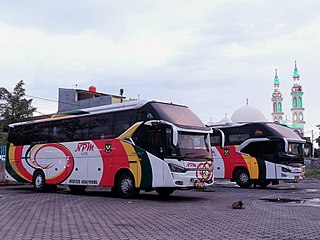
Perusahaan Otobus Naikilah Perusahaan Minang, abbreviated as PO NPM, is an Indonesian autobus company based in Padang Panjang, West Sumatra. Founded in 1937, it is the oldest operating autobus company in Indonesia.


